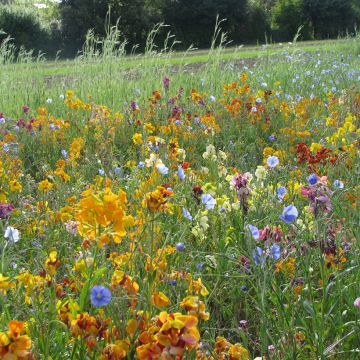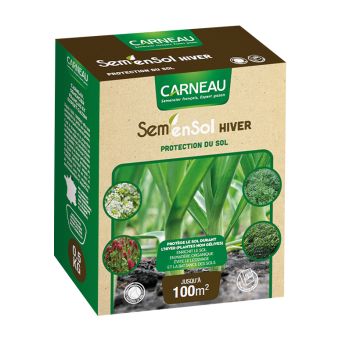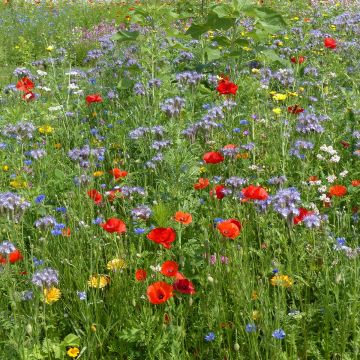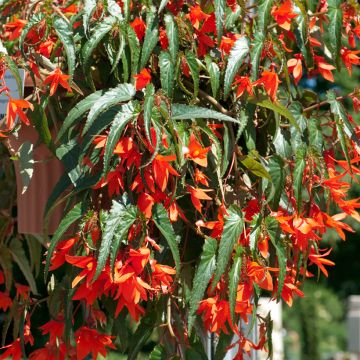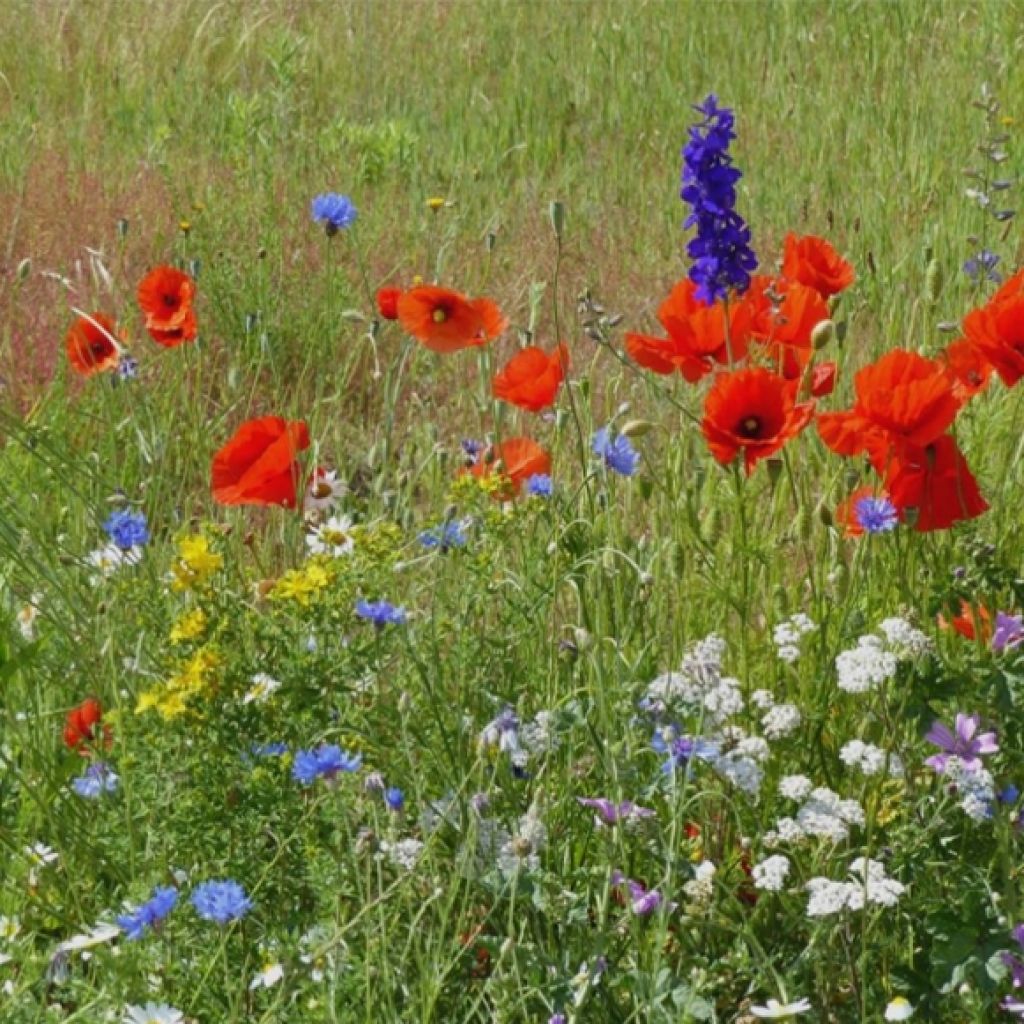

Graines OXIPOLI® - Mélange de fleurs annuelles pour 40 m²
Oxipoli Seeds - Mix of nectar-rich and honey-producing annual flowers to cover 40m²
I won't renew almost anything that came out. But this is not my first failure in my garden.
monique, 21/09/2024
This item cannot be shipped to the selected country
Dispatch by letter from €3.90
More information
Schedule delivery date,
and select date in basket
This plant carries a 6 months recovery warranty
More information
We guarantee the quality of our plants for a full growing cycle, and will replace at our expense any plant that fails to recover under normal climatic and planting conditions.
Seed-only orders are dispatched by sealed envelope. The delivery charge for seed-only orders is €3.90.

Does this plant fit my garden?
Set up your Plantfit profile →
Description
Oxipoli Market Gardening Annual Mix is a collection of annual flowers dedicated to "functional biodiversity," which relies on the ecosystem services provided to agriculture. The plants in this mix are as useful for beneficial insects and pollinators as they are beneficial for crop yield, all while respecting the environment. Easy to grow in ordinary soil and requiring very little maintenance, they can be sown directly in place in spring or autumn, in well-prepared and loosened soil, under the sun. The flowerbed or margin thus created will bloom for several weeks, providing an excellent refuge for biodiversity.
This selection consists of 21 species of annual plants that are fast-growing, hardy, and easy to grow, flowering 6 to 8 weeks after sowing. By staggering the sowings every month from March to June on several plots, the flowering periods and attractiveness of the mix can be extended. Some species easily naturalise through self-seeding in ordinary, well-draining soil. A box of seeds can cover up to 40 square metres. The height of the plants varies between 50 and 60cm (20 and 24in).
Sample composition: Sea Alyssum, Dill, Centaurea, Viper's Bugloss (Echium vulgare), Flax.
Sown in intercrop flower strips or field margins, this Oxipoli Market Gardening Annual Mix attracts beneficial insects such as lacewings, hoverflies and ladybirds, and pollinators (hymenoptera, bees, hoverflies) of the main market garden or fruit crops, optimising their yield.
It has become very popular to plant wildflower meadows. They bloom throughout the season, reduce the need for mowing, promote biodiversity, and require almost no care: watering if the weather is very dry and mowing to 10-20 cm (4-8in) above ground level in autumn will be more than enough. Ideal for adding colour and life to a sunny area, this Oxipoli Market Gardening mix will also be useful for hobbyists who own a few beehives.
Report an error about the product description
Flowering
Foliage
Plant habit
Botanical data
Cultivar or hybrid
Other Fallows and meadows in flower
Planting and care
Sowing: from March to June in all regions or in September-October (in mild climates)
Turn over the soil. Depending on the area, you can use a rototiller or agricultural equipment. • Refine, rake, level, remove rocks and weeds. • Mix the contents of the packet with an equal volume of dry sand to achieve a better distribution of the seeds. • Sow by broadcasting on the surface like sowing a lawn. • Roll or compact the soil to ensure contact between the seeds and the ground. • Water and keep moist until germination.
Sow approximately 2 to 3 grams/m² on a plot smaller than 1000 m². Beyond that, sow 10 to 15 kg/ha.
• 40 m²: sow the entire box
Cultivation:
To maintain a flowering meadow into the following year, scythe once flowering is over (late September or early October), and then mow again, without the grass box, to a height of 10cm (4in) from the ground. Many flowers will self-seed spontaneously.
Sowing period
Intended location
-
, onOrder confirmed
Reply from on Promesse de fleurs
Flower seeds
Haven't found what you were looking for?
Hardiness is the lowest winter temperature a plant can endure without suffering serious damage or even dying. However, hardiness is affected by location (a sheltered area, such as a patio), protection (winter cover) and soil type (hardiness is improved by well-drained soil).

Photo Sharing Terms & Conditions
In order to encourage gardeners to interact and share their experiences, Promesse de fleurs offers various media enabling content to be uploaded onto its Site - in particular via the ‘Photo sharing’ module.
The User agrees to refrain from:
- Posting any content that is illegal, prejudicial, insulting, racist, inciteful to hatred, revisionist, contrary to public decency, that infringes on privacy or on the privacy rights of third parties, in particular the publicity rights of persons and goods, intellectual property rights, or the right to privacy.
- Submitting content on behalf of a third party;
- Impersonate the identity of a third party and/or publish any personal information about a third party;
In general, the User undertakes to refrain from any unethical behaviour.
All Content (in particular text, comments, files, images, photos, videos, creative works, etc.), which may be subject to property or intellectual property rights, image or other private rights, shall remain the property of the User, subject to the limited rights granted by the terms of the licence granted by Promesse de fleurs as stated below. Users are at liberty to publish or not to publish such Content on the Site, notably via the ‘Photo Sharing’ facility, and accept that this Content shall be made public and freely accessible, notably on the Internet.
Users further acknowledge, undertake to have ,and guarantee that they hold all necessary rights and permissions to publish such material on the Site, in particular with regard to the legislation in force pertaining to any privacy, property, intellectual property, image, or contractual rights, or rights of any other nature. By publishing such Content on the Site, Users acknowledge accepting full liability as publishers of the Content within the meaning of the law, and grant Promesse de fleurs, free of charge, an inclusive, worldwide licence for the said Content for the entire duration of its publication, including all reproduction, representation, up/downloading, displaying, performing, transmission, and storage rights.
Users also grant permission for their name to be linked to the Content and accept that this link may not always be made available.
By engaging in posting material, Users consent to their Content becoming automatically accessible on the Internet, in particular on other sites and/or blogs and/or web pages of the Promesse de fleurs site, including in particular social pages and the Promesse de fleurs catalogue.
Users may secure the removal of entrusted content free of charge by issuing a simple request via our contact form.
The flowering period indicated on our website applies to countries and regions located in USDA zone 8 (France, the United Kingdom, Ireland, the Netherlands, etc.)
It will vary according to where you live:
- In zones 9 to 10 (Italy, Spain, Greece, etc.), flowering will occur about 2 to 4 weeks earlier.
- In zones 6 to 7 (Germany, Poland, Slovenia, and lower mountainous regions), flowering will be delayed by 2 to 3 weeks.
- In zone 5 (Central Europe, Scandinavia), blooming will be delayed by 3 to 5 weeks.
In temperate climates, pruning of spring-flowering shrubs (forsythia, spireas, etc.) should be done just after flowering.
Pruning of summer-flowering shrubs (Indian Lilac, Perovskia, etc.) can be done in winter or spring.
In cold regions as well as with frost-sensitive plants, avoid pruning too early when severe frosts may still occur.
The planting period indicated on our website applies to countries and regions located in USDA zone 8 (France, United Kingdom, Ireland, Netherlands).
It will vary according to where you live:
- In Mediterranean zones (Marseille, Madrid, Milan, etc.), autumn and winter are the best planting periods.
- In continental zones (Strasbourg, Munich, Vienna, etc.), delay planting by 2 to 3 weeks in spring and bring it forward by 2 to 4 weeks in autumn.
- In mountainous regions (the Alps, Pyrenees, Carpathians, etc.), it is best to plant in late spring (May-June) or late summer (August-September).
The harvesting period indicated on our website applies to countries and regions in USDA zone 8 (France, England, Ireland, the Netherlands).
In colder areas (Scandinavia, Poland, Austria...) fruit and vegetable harvests are likely to be delayed by 3-4 weeks.
In warmer areas (Italy, Spain, Greece, etc.), harvesting will probably take place earlier, depending on weather conditions.
The sowing periods indicated on our website apply to countries and regions within USDA Zone 8 (France, UK, Ireland, Netherlands).
In colder areas (Scandinavia, Poland, Austria...), delay any outdoor sowing by 3-4 weeks, or sow under glass.
In warmer climes (Italy, Spain, Greece, etc.), bring outdoor sowing forward by a few weeks.

































